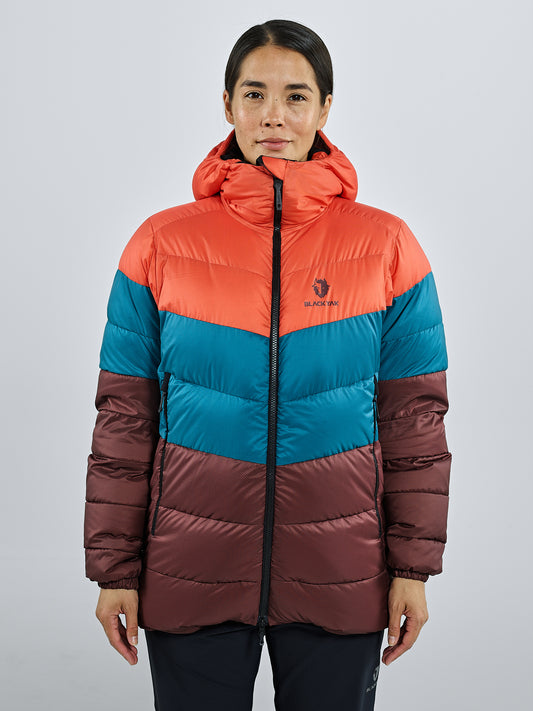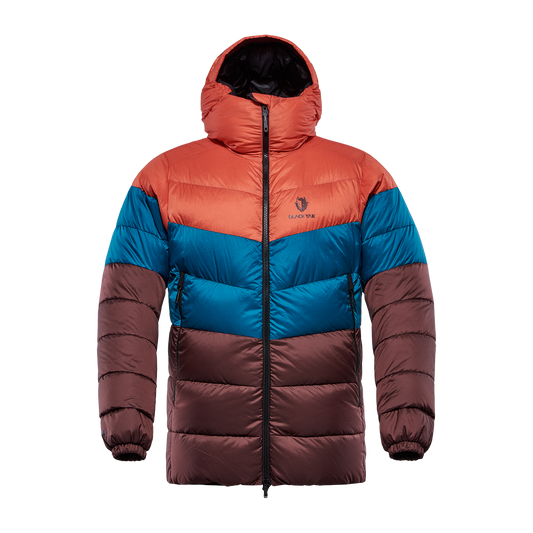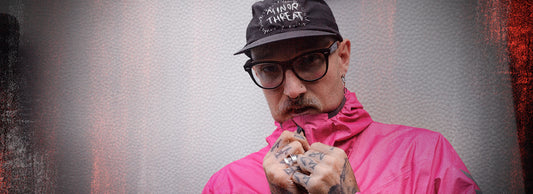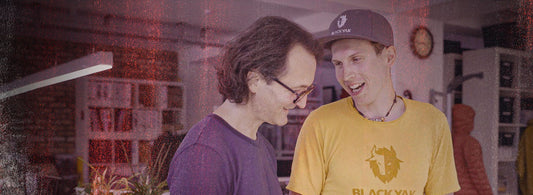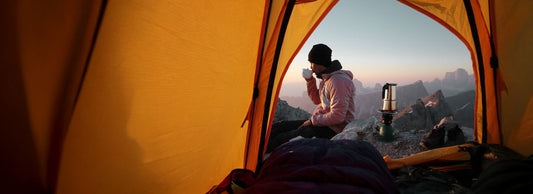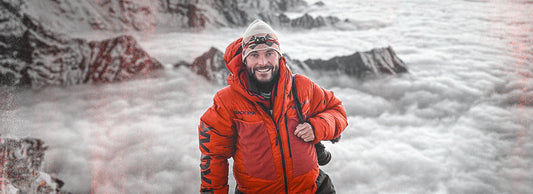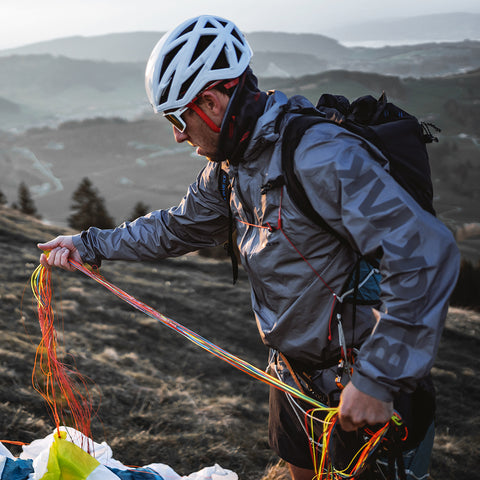Steep, icy passages, rocky cliffs, and the huge seracs staring at us…
This is Annapurna-I, the tenth-highest mountain in the world, with an elevation of 8,091m (26,545ft) above sea level. It is located in the Himalayas of north-central Nepal and is part of the Annapurna Massif, a range that includes several peaks over 7,000m (22,966ft). Annapurna-I is considered one of the most challenging and dangerous mountains to climb, due to its steep and exposed routes and the frequent avalanches and landslides that occur on its slopes.

My journey begins many years back, but now I will take you with me on the actual climb and days preparing in the camps at the mountain.
Life in Base Camp (BC)

We all settled into our tents and quickly adjusted into the few routines. This is such an intense way of living, so close to nature and so close to our new family, our mountain family. We share everything together and we are not distracted by the outside world. It is all about the mountain.

We all share our meals together in the mess tent, and wow how the kitchen staff spoiled us. It is just amazing what they can conjure up from that primitive kitchen. And always when we came back from a rotation up in the mountains, they offered us bucket shower!
The weather was a bit of everything, so we had some snowfalls which means that the conditions up in the mountain becomes dangerous and we wait it out in Base Camp. Then we played cards, played volleyball, prepared equipment, washed clothes, read books and visited other groups in BC. Other days waiting for the right weather window we went for nice walks to the nearby peaks.
Lama who worked in the kitchen, made a wonderful Puja ceremony for us before we started climbing up the mountain.

This ceremony is an important tradition where we ask the mountain Gods for permission to climb the mountain. Lama and the kitchen staff made good food, baked cookies and decorated our Mani which is an altar made of rocks. The prayer flags were hanging from the Mani, stretched out over our camp to protect us and to wave in the wind, sending all our wishes with the wind.

First rotation up the mountain
After 4 days in BC, the weather was good enough to start our acclimatization and climb to preposition our gear up in the mountain.
The first part of the route was alongside the glacier on a nice rocky, partly green slope before we came to a place, we called crampons point.

This was the place, we stored out crampons, helmet, harness and big boots. From there we rappel down and cross a part of the glacier to start the climb up at the left side of the glacier-fall which is like a waterfall of ice. The glacier is very much alive; we could hear it rumble all the time, and could see the avalanches, some small, dust clouds, and some big, rumbling down.
The climb up to camp 1 at 5050 m was a rocky and icy steep climb and the view was getting better and better every time I turned around.
Before we reached camp 1, the weather changed into cold wind and snow. Still, we had to climb for more than one hour in the bad weather. Some climbers slowed down, but this was not the time to slow down. Keep on climbing and get to camp 1 as fast and safe as possible. It was good to reach camp 1 and get into the tents as the wind picked up. The day after it was clear sky and no wind, so we started our climb up to camp 2.

The first part was an easy crossing of the glacier before a nice climb snow/ice up to camp 2 at 5500m. The weather pattern was staying the same. About 13:00/14:00 o`clock every day the clouds were building up and giving us some snow showers before it cleared up at evening time.

We had beautiful views from camp 2. Not so good sleep, but it is always like this the first night when I reach a high altitude. The morning after I had a relaxing and slow climb up to 5700 m before descending to camp 2 and our second night there before heading back to Base Camp the morning after.
Summit push BC to C3
The weather was coming and going, we had days with a lot of snow falling, but after some days waiting in Base Camp, we finally had a weather window ahead of us with enough days of good weather and little wind so we could start our climb up.

First, we climbed the rocky part up to camp 1 and had a night there before we crossed the glacier and climbed up to camp 2 and slept one night there.
The third day we were up for the most dangerous part of the climb: between camp 2 and camp 3. We started out early in the morning to try to cross the dangerous couloir before the sun hit the big glacier at the top of the couloir. When the sun hits it, it starts dropping snow and ice, and everything comes down this couloir. It is like a funnel for the avalanches. And we had to cross the lower part of that “funnel”.

But first we had to cross the whole runout zone. That is like a big plateau towards the face, right below the overhanging serac along the so-called “Sickle”. It is a very dangerous place because of serac falls. It gets even more dangerous when we get closer to the wall and heads towards the characteristic cone-shaped couloir, with a great serac on top. That serac is usually loaded with snow, and pieces of it breaks off and fall into the couloir which is like a funnel leading straight towards us. It takes us about 1 hour in the dangerous areas of the runout zone and the crossing.
We are all happy when we have crossed the area, but also concerned for our climbing friends behind us. We continue climbing the rocky more technical part and further up the ice. The last bit before camp 3 was a 20-meter wall of overhang climb. People were stuck, the rope fixing team were struggling.

The weather started to pick up; the wind increased, and it started snowing. Some of my climbing friends sat down and gave up moving their feet and fingers, that is so dangerous. Some gave up the wall and pinched their tent right there below the wall. We were still some of us trying to climb the wall with the wind gusts coming down the ice wall hitting us right in the face.

It was a challenging climb, we struggled to get up, and to get with us all our gear which we pulled up in ropes, so we didn’t have to climb with packs on our backs. We managed to get up after some time struggle, and at the top of the ice wall we established camp 3 and had a good night’s rest. Camp 3 is set up between huge seracs, just below the slope leading to Camp 4.

Summit push
From Camp 3 we had a nice climb up to camp 4 at 6700 m and then we started preparing for our push for the summit.
We started climbing at about 8pm in a wonderful night full of stars and nearly no wind. But it was a dark night. No moon to shine its light on us. It was a loooong uphill the whole night. I must admit that both me and my Sherpa Cheppal walked like zombies at some times during that night. But we kind of woke each other up during our walk. So many times, I was looking up and wondering if it was headlamps or stars ahead of me. Staring at them, moving…ahhh once again a climber’s headlamp and not a star. Not moving…. stars: yey! That meant that it was above the mountain, and we could hope for reaching the top in time.
After the whole night climbing, the light started to appear, and then the sunrise. Wow, so beautiful! Giving us so much energy! Still, we had a long hill in front of us, but now we also had the view, and we could see the top. Some climbers were already on their way down, we congratulated them and heard about the remaining route. The wind picked up, but not too bad. Right below the top, we had to climb up a part where the snow was rushing down, it felt like two step up, and one down, and it took a lot of time and energy.

Then the last little bit.
And wow what an amazing view at the top!! Suddenly I could see all the mountains at the other side of the loooong hill I had struggled to get to the top of. Panoramic view of the surrounding mountains and valleys; Amazing, Wonderful and breathtaking!!!

I spent around 45 minutes at the top before we started our way down. Cheppal and I teamed up with two other climbers and roped up at some of the steep parts.

We had a relaxing and good time on our way down. We even sat down, put up our jet boil and melted snow, having a good cup of tea enjoying the view halfway down. We reached camp 4 in good time before it got cold and dark. There we had food and relaxed.

We decided to spend the night there as some of the other climbers didn’t want to continue. The morning after we climbed down to camp 3 and continued down the ice walls and crossing the couloir and the runout zone of the couloir.
Just minutes after we reached camp 2, the expedition took a tragic turn; we heard the desperate call for help at the radio: «Anurag went into a crevasse». We all turned around and changed focus. At first, we didn’t understand where it had happened but Cheppal ran up to the couloir. And there at the bottom of the couloir, before the runout zone, Anurag had fallen into a crevasse. Oswald and Bartek, two very strong and skilled Polish climbers, tried to reach him but had too short ropes and the avalanches started to run down the mountain as the temperature increased. They shouted but it was totally silent from down the crevasse. Only the sound of rumbling snow.
That night we arrived base camp very late, in the dark. Everything felt dark, and the morning after we woke up to the sad news that Noel Hannah didn’t wake up from his sleep in the high camp after summit. He followed his dream, he spread the ashes from his dogs at the summit, but he never came back to his beloved wife and family. Rest in peace dear Noel.

The next happening in base camp is that we get news that one of our friends, an Indian female climber is lost and most likely have died on her way down from the summit. Luckily helicopter pilot Claudio don’t want to give up and settle with that news, so he flies up to check. He finds her and manage to long-line evacuate her back to base camp. Finally, some good news!

We are all so happy. She is saved and in good shape!
Three days later Adam Bielecki and Mariusz Hatala with Cheppal Sherpa, Lakpa Nurbu Sherpa, Dawa Nurbu Sherpa, Lakpa Sherpa, Tashi Sherpa, Chhang Dawa Sherpa (ground handeling), and helicopter pilot Sobit Gauchan tried again to reach Anurag. He was found nearly 60 m down in the crevasse. We all were so happy: he was still alive. I feel he was born again. I wish him all the best and a speedy recovery!!

The expedition came to an end: It is a strange feeling when the family you have had, and been so close to, suddenly disappear. We have shared ups and downs; we have won and we have lost….
Read more about Anurag Maloos rescue:
https://global.blackyak.com/en/blogs/news/rettungsaktion-an-der-annapurna
FACTS:
An expedition to Annapurna-I requires a high level of physical fitness, technical climbing skills, and experience in high-altitude mountaineering. It is also important to properly acclimatize to the altitude, have the right gear, and be prepared for the risks of avalanches, landslides, and other hazards.
Altitude of the camps:
- Basecamp is set at (4,190m/13,747ft)
- Camp I (5,050m/16,568ft)
- Camp II (5,600m/18,372ft)
- Camp III (6,500m/21,325ft)
- Camp IV (6,700m/21,981ft)
- Summit Annapurna (8,091m/26,545ft).
Annapurna is one of two (with K2) of the world's most dangerous mountains to climb, with a bad fatality-to-summit ratio.
-
WOMEN'S MANDU HOODED EXPEDITION DOWN JACKET
The secret to its incredible performance lies inside the MANDU HOODED EXPEDIT...Regular price 980,00 €Regular priceUnit price per



